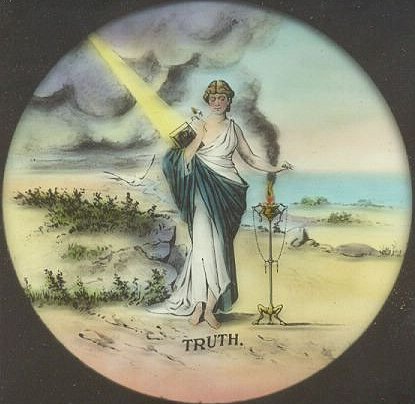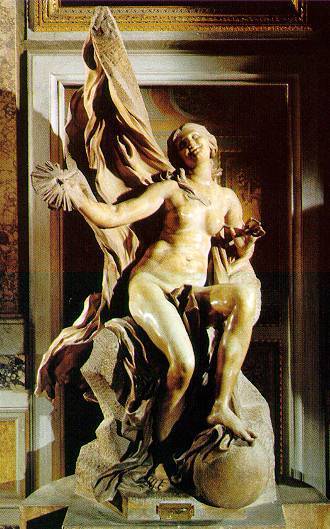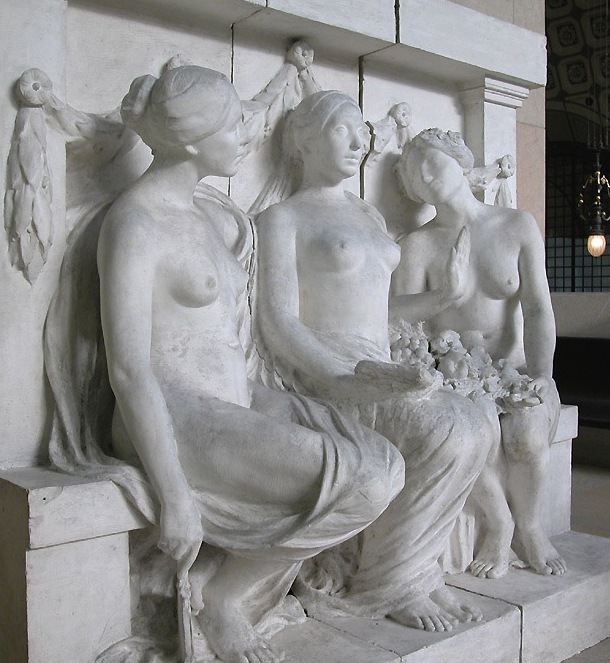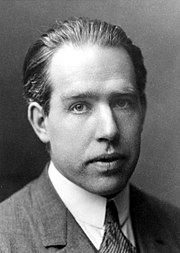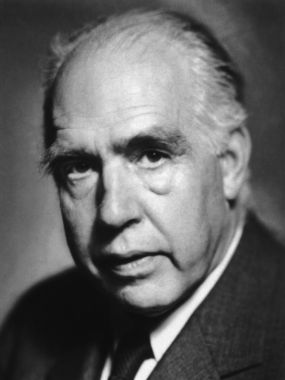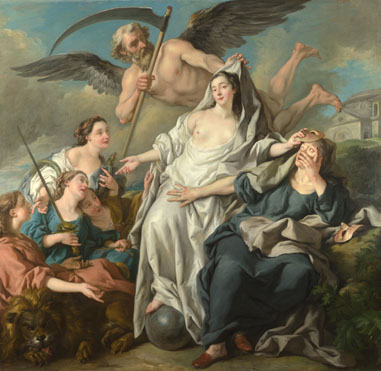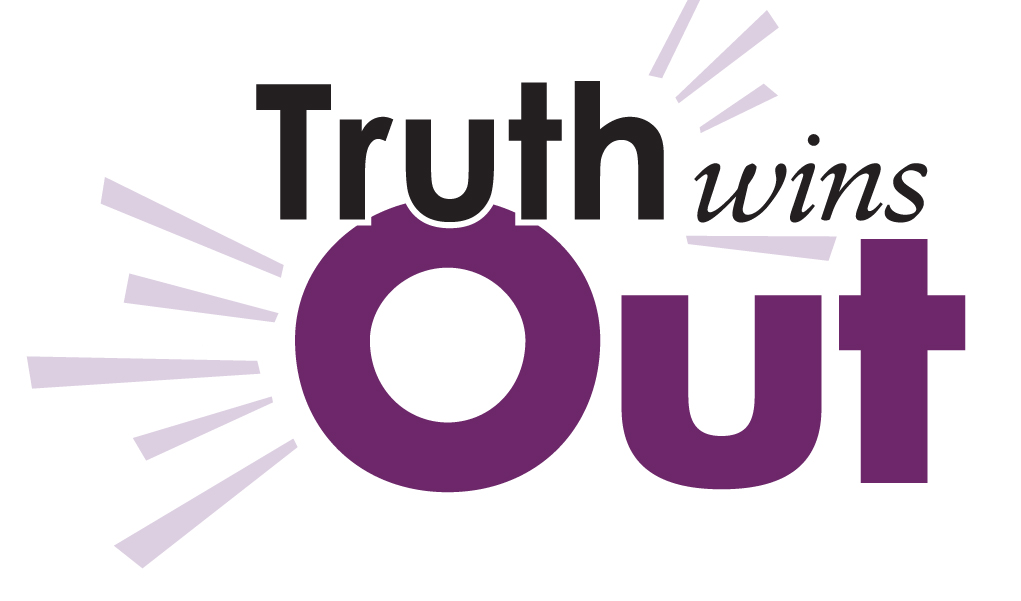From Wikipedia, the free encyclopedia
From:
Wikipedia: This
page was last modified on 12 September 2010 at 19:50. For latest
update please click on hyperlink.
Truth can have a variety of meanings, from the state of
being the case, being in accord with a particular fact or reality,
being in accord with the body of
real
things, events, actuality, or fidelity to an original or to a
standard, truth "behind" everything, the ontological truth. In
archaic usage it could be fidelity, constancy or sincerity in
action, character, and utterance.[1]
Various
theories and views of truth continue to be debated among
scholars and philosophers.
There are differing claims on such
questions as what constitutes truth; what things are
truthbearers capable of being true or false; how to define and
identify truth; the roles that revealed and acquired knowledge play;
and whether truth is
subjective,
relative,
objective, or
absolute. This article introduces the various perspectives and
claims, both today and throughout history.
Nomenclature, orthography and etymology
The English word
truth is from
Old English tríewþ, tréowþ, trýwþ,
Middle English trewþe, cognate to
Old High German triuwida,
Old Norse tryggð. Like
troth, it is a
-th nominalisation of the adjective true (Old English
tréowe).
The English word
true is from Old English (West
Saxon) (ge)tríewe,
tréowe, cognate to
Old Saxon (gi)trûui,
Old High German (ga)triuwu (Modern
German treu "faithful"),
Old Norse tryggr,
Gothic triggws,[2]
all from a
Proto-Germanic *trewwj- "having
good faith". Old Norse trú,
"faith, word of honour; religious faith, belief"[3]
(archaic English
troth "loyalty, honesty, good faith", compare
Ásatrú).
Thus, 'truth' involves both the quality of "faithfulness,
fidelity, loyalty, sincerity, veracity",[4]
and that of "agreement with
fact or
reality", in Anglo-Saxon expressed by
soþ (Modern English
sooth).
All Germanic languages besides English have introduced a
terminological distinction between truth "fidelity" and truth
"factuality". To express "factuality",
North Germanic opted for nouns derived from sanna "to
assert, affirm", while continental
West Germanic (German and Dutch) opted for continuations of
wâra "faith, trust, pact" (cognate to Slavic vera
"(religious) faith", but influenced by Latin
verus).
Romance languages use terms following the Latin
veritas, while the Greek
aletheia and Slavic
pravda have separate etymological origins.
The major
theories of truth
The question of what is a proper basis for deciding how words,
symbols, ideas and beliefs may properly be considered true, whether
by a single person or an entire society, is dealt with by the five
major substantive theories introduced below. Each theory presents
perspectives that are widely shared by published scholars.[5][6]
There also have more recently arisen "deflationary"
or "minimalist" theories of truth based on the idea that the
application of a term like true to a statement does not
assert anything significant about it, for instance, anything about
its nature, but that the label truth is a tool of
discourse used to express agreement, to emphasize claims, or to form
certain types of generalizations.[5][7][8]
Substantive
theories
Correspondence
theory
Correspondence theories state that true beliefs and true
statements correspond to the actual state of affairs.[9]
This type of theory posits a relationship between thoughts or
statements on the one hand, and things or objects on the other. It
is a traditional model which goes back at least to some of the
classical Greek philosophers such as
Socrates,
Plato,
and
Aristotle.[10]
This class of theories holds that the truth or the falsity of a
representation is determined in principle solely by how it relates
to "things", by whether it accurately describes those "things".
An
example of correspondence theory is the statement by the Thirteenth
Century philosopher/theologian
Thomas Aquinas: Veritas est adaequatio rei et intellectus
("Truth is the equation [or adequation] of things and intellect"), a
statement which Aquinas attributed to the Ninth Century
neoplatonist
Isaac Israeli.[11][12]
Aquinas also restated the theory as: “A judgment is said to be true
when it conforms to the external reality”
[13]
Correspondence theory practically operates on the assumption that
truth is a matter of accurately copying what was much later called "objective
reality" and then representing it in thoughts, words and other
symbols.[14]
Many modern theorists have stated that this ideal cannot be achieved
independently of some analysis of additional factors.[5][15]
For example, language plays a role in that all languages have words
that are not easily translatable into another. The
German word
Zeitgeist is one such example: one who speaks or understands
the language may "know" what it means, but any translation of the
word fails to accurately capture its full meaning (this is a problem
with many abstract words, especially those derived in
agglutinative languages).
Thus, some words add an additional
parameter to the construction of an accurate
truth predicate. Among the philosophers who grappled with this
problem is
Alfred Tarski, whose
semantic theory is summarized further below in this article.[16]
Proponents of several of the theories below have gone further to
assert that there are yet other issues necessary to the analysis,
such as interpersonal power struggles, community interactions,
personal biases and other factors involved in deciding what is seen
as truth.
Coherence theory
For coherence theories in general, truth requires a proper fit of
elements within a whole system. Very often, though, coherence is
taken to imply something more than simple logical consistency; often
there is a demand that the propositions in a coherent system lend
mutual inferential support to each other. So, for example, the
completeness and comprehensiveness of the underlying set of concepts
is a critical factor in judging the validity and usefulness of a
coherent system.[17]
A pervasive tenet of coherence theories is the idea that truth is
primarily a property of whole systems of propositions, and can be
ascribed to individual propositions only according to their
coherence with the whole. Among the assortment of perspectives
commonly regarded as coherence theory, theorists differ on the
question of whether coherence entails many possible true systems of
thought or only a single absolute system.
Some variants of coherence theory are claimed to characterize the
essential and intrinsic properties of
formal systems in logic and mathematics.[18]
However, formal reasoners are content to contemplate
axiomatically independent and sometimes mutually contradictory
systems side by side, for example, the various
alternative geometries. On the whole, coherence theories have
been criticized as lacking justification in their application to
other areas of truth, especially with respect to assertions about
the
natural world,
empirical data in general, assertions about practical matters of
psychology and society, especially when used without support from
the other major theories of truth.[19]
Coherence theories distinguish the thought of
rationalist philosophers, particularly of
Spinoza,
Leibniz, and
G.W.F. Hegel, along with the British philosopher
F.H. Bradley.[20]
They have found a resurgence also among several proponents of
logical positivism, notably
Otto Neurath and
Carl Hempel.
Constructivist
theory
Social constructivism holds that truth is constructed by social
processes, is historically and culturally specific, and that it is
in part shaped through the power struggles within a community.
Constructivism views all of our knowledge as "constructed," because
it does not reflect any external "transcendent" realities (as a pure
correspondence theory might hold). Rather, perceptions of truth are
viewed as contingent on convention, human perception, and social
experience. It is believed by constructivists that representations
of physical and biological reality, including
race,
sexuality, and
gender
are socially constructed.
Giambattista Vico was among the first to claim that history and
culture were man-made. Vico's
epistemological orientation gathers the most diverse rays and
unfolds in one axiom – verum ipsum factum – "truth itself is
constructed".
Hegel and
Marx were among the other early proponents of the premise that
truth is, or can be, socially constructed. Marx, like many critical
theorists who followed, did not reject the existence of objective
truth but rather distinguished between true knowledge and knowledge
that has been distorted through power or ideology. For Marx
scientific and true knowledge is 'in accordance with the dialectical
understanding of history' and ideological knowledge 'an
epiphenomenal expression of the relation of material forces in a
given economic arrangement'.[21]
Consensus theory
Consensus theory holds that truth is whatever is agreed upon, or
in some versions, might come to be agreed upon, by some specified
group. Such a group might include all human beings, or a
subset
thereof consisting of more than one person.
Among the current advocates of consensus theory as a useful
accounting of the concept of "truth" is the philosopher
Jürgen Habermas.[22]
Habermas maintains that truth is what would be agreed upon in an
ideal speech situation.[23]
Among the current strong critics of consensus theory is the
philosopher
Nicholas Rescher.[24]
Pragmatic theory
The three most influential forms of the pragmatic theory of
truth were introduced around the turn of the 20th century by
Charles Sanders Peirce,
William James, and
John Dewey. Although there are wide differences in viewpoint
among these and other proponents of pragmatic theory, they hold in
common that truth is verified and confirmed by the results of
putting one's concepts into practice.[25]
Peirce defines truth as follows: "Truth is that concordance of
an abstract statement with the ideal limit towards which endless
investigation would tend to bring scientific belief, which
concordance the abstract statement may possess by virtue of the
confession of its inaccuracy and one-sidedness, and this confession
is an essential ingredient of truth."[26]
This statement emphasizes Peirce's view that ideas of approximation,
incompleteness, and partiality, what he describes elsewhere as
fallibilism and "reference to the future", are essential to
a proper conception of truth. Although Peirce uses words like
concordance and correspondence to describe one aspect of
the pragmatic
sign relation, he is also quite explicit in saying that
definitions of truth based on mere correspondence are no more than
nominal definitions, which he accords a lower status than
real definitions.
William James's version of pragmatic theory, while complex, is
often summarized by his statement that "the 'true' is only the
expedient in our way of thinking, just as the 'right' is only the
expedient in our way of behaving."[27]
By this, James meant that truth is a quality the value of which is
confirmed by its effectiveness when applying concepts to actual
practice (thus, "pragmatic").
John Dewey, less broadly than James but more broadly than
Peirce, held that inquiry, whether scientific, technical,
sociological, philosophical or cultural, is self-corrective over
time if openly submitted for testing by a community of
inquirers in order to clarify, justify, refine and/or refute
proposed truths.[28]
Minimalist (deflationary) theories
A number of philosophers reject the thesis that the concept or
term truth refers to a real property of sentences or
propositions. These philosophers are responding, in part, to the
common use of truth predicates (e.g., that some particular
thing "...is true") which was particularly prevalent in
philosophical discourse on truth in the first half of the 20th
century. From this point of view, to assert the proposition “2 + 2 =
4' is true” is logically equivalent to asserting the proposition “2
+ 2 = 4”, and the phrase “is true” is completely dispensable in this
and every other context. These positions are broadly described
- as deflationary theories of truth, since they attempt
to deflate the presumed importance of the words "true" or
truth,
- as disquotational theories, to draw attention to the
disappearance of the quotation marks in cases like the above
example, or
- as minimalist theories of truth.[5][29]
Whichever term is used, deflationary theories can be said to hold
in common that "[t]he predicate 'true' is an expressive convenience,
not the name of a property requiring deep analysis."[5]
Once we have identified the truth predicate's formal features and
utility, deflationists argue, we have said all there is to be said
about truth. Among the theoretical concerns of these views is to
explain away those special cases where it does appear that
the concept of truth has peculiar and interesting properties. (See,
e.g.,
Semantic paradoxes, and below.)
In addition to highlighting such formal aspects of the predicate
"is true", some deflationists point out that the concept enables us
to express things that might otherwise require infinitely long
sentences. For example, one cannot express confidence in Michael's
accuracy by asserting the endless sentence:
- Michael says, 'snow is white' and snow is white, or he
says 'roses are red' and roses are red or he says ... etc.
This assertion can also be succinctly expressed by saying:
What Michael says is true.[30]
Performative theory of truth
Attributed to
P. F. Strawson is the performative theory of truth which holds
that to say "'Snow is white' is true" is to perform the
speech act of signaling one's agreement with the claim that snow
is white (much like nodding one's head in agreement). The idea that
some statements are more actions than communicative statements is
not as odd as it may seem.
Consider, for example, that when the
bride says "I do" at the appropriate time in a wedding, she is
performing the act of taking this man to be her lawful wedded
husband. She is not describing herself as taking this man,
but actually doing so (perhaps the most thorough analysis of such
"illocutionary acts" is
J. L. Austin, "How
to Do Things With Words"[31]).
Strawson holds that a similar analysis is applicable to all
speech acts, not only to illocutionary ones: "To say a statement is
true is not to make a statement about a statement, but rather to
perform the act of agreeing with, accepting, or endorsing a
statement. When one says 'It's true that it's raining,' one asserts
no more than 'It's raining.' The function of [the statement] 'It's
true that...' is to agree with, accept, or endorse the statement
that 'it's raining.'"[32]
Redundancy and related theories
According to the
redundancy theory of truth, asserting that a statement is true
is completely equivalent to asserting the statement itself. For
example, making the assertion that " 'Snow is white' is true" is
equivalent to asserting "Snow is white".
Redundancy theorists infer
from this premise that truth is a redundant concept; that is, it is
merely a word that is traditionally used in conversation or writing,
generally for emphasis, but not a word that actually equates to
anything in reality.
This theory is commonly attributed to
Frank P. Ramsey, who held that the use of words like fact
and truth was nothing but a
roundabout way of asserting a proposition, and that treating
these words as separate problems in isolation from judgment was
merely a "linguistic muddle".[5][33][34]
A variant of redundancy theory is the disquotational theory which
uses a modified form of
Tarski's
schema: To say that '"P" is true' is to say that P. Yet another
version of deflationism is the
prosentential theory of truth, first developed by Dorothy
Grover, Joseph Camp, and
Nuel Belnap as an elaboration of Ramsey's claims.
They argue
that sentences like "That's true", when said in response to "It's
raining", are
prosentences, expressions that merely repeat the content of
other expressions. In the same way that it means the same as
my dog in the sentence My dog was hungry, so I fed it,
That's true is supposed to mean the same as It's raining
— if you say the latter and I then say the former.
These variations
do not necessarily follow Ramsey in asserting that truth is not
a property, but rather can be understood to say that, for instance,
the assertion "P" may well involve a substantial truth, and the
theorists in this case are minimalizing only the redundancy or
prosentence involved in the statement such as "that's true."[5]
Deflationary principles do not apply to representations that are
not analogous to sentences, and also do not apply to many other
things that are commonly judged to be true or otherwise. Consider
the analogy between the sentence "Snow is white" and the character
named Snow White, both of which can be true in some sense. To a
minimalist, saying "Snow is white is true" is the same as saying
"Snow is white," but to say "Snow White is true" is not the
same as saying "Snow White."
Pluralist theories
Several of the major theories of truth hold that there is a
particular property the having of which makes a belief or
proposition true. Pluralist theories of truth assert that there may
be more than one property that makes propositions true: ethical
propositions might be true by virtue of coherence. Propositions
about the physical world might be true by corresponding to the
objects and properties they are about.
Some of the pragmatic theories, such as those by
Charles Peirce and
William James, included aspects of correspondence, coherence and
constructivist theories.[26][27]
Crispin Wright argued in his 1992 book Truth and Objectivity
that any predicate which satisfied certain platitudes about truth
qualified as a truth predicate. In some discourses, Wright argued,
the role of the truth predicate might be played by the notion of
superassertibility.[35]
Michael Lynch, in a 2009 book Truth as One and Many,
argued that we should see truth as a functional property capable of
being multiply manifested in distinct properties like correspondence
or coherence.[36]
Most believed
theoriesAccording to a survey of professional philosophers and others on
their philosophical views which was carried out in November 2009
(taken by 3226 respondents, including 1803 philosophy faculty
members and/or PhDs and 829 philosophy graduate students) 44.9% of
respondents accept or lean towards correspondence theories, 20.7%
accept or lean towards deflationary theories and 13.8% epistemic
theories.[37]
Formal theories
Truth in logic
Logic
is concerned with the patterns in
reason
that can help tell us if a
proposition is true or not. However, logic does not deal with
truth in the absolute sense, as for instance a
metaphysician does. Logicians use
formal languages to express the truths which they are concerned
with, and as such there is only truth under some
interpretation or truth within some
logical system.
A logical truth (also called an analytic truth or a necessary
truth) is a statement which is true in all possible worlds[38]
or under all possible interpretations, as contrasted to a
fact
(also called a
synthetic claim or a
contingency) which is only true in this
world as it has historically unfolded. A proposition such as “If
p and q, then p.” is considered to be logical truth because it is
true because of the meaning of the
symbols and
words in it and not because of any facts of any particular
world. They are such that they could not be untrue.
Truth in
mathematics
There are two main approaches to truth in mathematics. They are
the
model theory of truth and the
proof theory of truth[citation
needed].
Historically, with the nineteenth century development of
Boolean algebra mathematical models of logic began to treat
"truth", also represented as "T" or "1", as an arbitrary constant.
"Falsity" is also an arbitrary constant, which can be represented as
"F" or "0". In
propositional logic, these symbols can be manipulated according
to a set of
axioms and
rules of inference, often given in the form of
truth tables.
In addition, from at least the time of
Hilbert's program at the turn of the twentieth century to the
proof of
Gödel's theorem and the development of the
Church-Turing thesis in the early part of that century, true
statements in mathematics were generally assumed to be those
statements which are provable in a formal axiomatic system.
The works of
Kurt Gödel,
Alan Turing, and others shook this assumption, with the
development of statements that are true but cannot be proven within
the system.[39]
Two examples of the latter can be found in
Hilbert's problems. Work on
Hilbert's 10th problem led in the late twentieth century to the
construction of specific
Diophantine equations for which it is undecidable whether they
have a solution,[40]
or even if they do, whether they have a finite or infinite number of
solutions.
More fundamentally,
Hilbert's first problem was on the
continuum hypothesis.[41]
Gödel and
Paul Cohen showed that this hypothesis cannot be proved or
disproved using the standard
axioms
of
set theory and a finite number of proof steps.[42]
In the view of some, then, it is equally reasonable to take either
the continuum hypothesis or its negation as a new axiom.
Semantic
theory of truthThe
semantic theory of truth has as its general case for a given
language:
- 'P' is true if and only if P
where 'P' is a reference to the sentence (the sentence's name),
and P is just the sentence itself.
Logician and philosopher
Alfred Tarski developed the theory for formal languages (such as
formal logic). Here he restricted it in this way: no language
could contain its own truth predicate, that is, the expression is
true could only apply to sentences in some other language. The
latter he called an object language, the language being
talked about. (It may, in turn, have a truth predicate that can be
applied to sentences in still another language.) The reason for his
restriction was that languages that contain their own truth
predicate will contain paradoxical sentences like the Liar: This
sentence is not true.
See
The Liar paradox.
As a result Tarski held that the semantic
theory could not be applied to any natural language, such as
English, because they contain their own truth predicates.
Donald Davidson used it as the foundation of his
truth-conditional semantics and linked it to
radical interpretation in a form of
coherentism.
Bertrand Russell is credited with noticing the existence of such
paradoxes even in the best symbolic formalizations of mathematics in
his day, in particular the paradox that came to be named after him,
Russell's paradox. Russell and
Whitehead attempted to solve these problems in
Principia Mathematica by putting statements into a hierarchy
of
types, wherein a statement cannot refer to itself, but only to
statements lower in the hierarchy. This in turn led to new orders of
difficulty regarding the precise natures of types and the structures
of conceptually possible
type systems that have yet to be resolved to this day.
Kripke's
theory of truth
Saul Kripke contends that a natural language can in fact contain
its own truth predicate without giving rise to contradiction. He
showed how to construct one as follows:
- Begin with a subset of sentences of a natural language that
contains no occurrences of the expression "is true" (or "is
false"). So The barn is big is included in the subset,
but not " The barn is big is true", nor problematic
sentences such as "This sentence is false".
- Define truth just for the sentences in that subset.
- Then extend the definition of truth to include sentences
that predicate truth or falsity of one of the original subset of
sentences. So "The barn is big is true" is now included,
but not either "This sentence is false" nor "'The barn
is big is true' is true".
- Next, define truth for all sentences that predicate truth or
falsity of a member of the second set. Imagine this process
repeated infinitely, so that truth is defined for The barn is
big; then for "The barn is big is true"; then for "'The
barn is big is true' is true", and so on.
Notice that truth never gets defined for sentences like This
sentence is false, since it was not in the original subset and
does not predicate truth of any sentence in the original or any
subsequent set. In Kripke's terms, these are "ungrounded." Since
these sentences are never assigned either truth or falsehood even if
the process is carried out infinitely, Kripke's theory implies that
some sentences are neither true nor false. This contradicts the
Principle of bivalence: every sentence must be either true or
false. Since this principle is a key premise in deriving the Liar
paradox, the paradox is dissolved.[43]
Notable views
Ancient history
The ancient
Greek origins of the words "true" and "truth" have some
consistent definitions throughout great spans of history that were
often associated with topics of
logic,
geometry,
mathematics,
deduction,
induction, and
natural philosophy.
Socrates',
Plato's
and
Aristotle's ideas about truth are commonly seen as consistent
with correspondence theory. In his
Metaphysics, Aristotle stated: “To say of what is that it is
not, or of what is not that it is, is false, while to say of what is
that it is, and of what is not that it is not, is true”.[44]
The
Stanford Encyclopedia of Philosophy proceeds to say of
Aristotle:
Aristotle sounds much more like a genuine correspondence
theorist in the Categories (12b11, 14b14), where he talks
of “underlying things” that make statements true and implies
that these “things” (pragmata) are logically structured
situations or facts (viz., his sitting, his not sitting). Most
influential is his claim in De Interpretatione (16a3)
that thoughts are “likenessess” (homoiosis) of things. Although
he nowhere defines truth in terms of a thought's likeness to a
thing or fact, it is clear that such a definition would fit well
into his overall philosophy of mind.[44]
Very similar statements can also be found in Plato (Cratylus
385b2, Sophist 263b).[44]
Medieval age
Avicenna
n
early Islamic philosophy,
Avicenna (Ibn Sina) defined truth in his Metaphysics of Healing,
Book I, Chapter 8, as:
What corresponds in the mind to what is outside it.
[45]
Avicenna elaborated on his definition of truth in his
Metaphysics Book Eight, Chapter 6:
The truth of a thing is the property of the being of each
thing which has been established in it.
[46]
However, this definition is merely a translation of the Latin
translation from the Middle Ages.[47]
A modern translation of the original Arabic text states:
Truth is also said of the veridical belief in the existence
[of something].
[48]
Aquinas
Following Avicenna, and also Augustine and Aristotle,
Thomas Aquinas stated in his Disputed Questions on Truth:
A natural thing, being placed between two intellects, is
called
true insofar as it conforms to either. It is
said to be true with respect to its conformity with the
divine intellect insofar as it fulfills the end to which it
was ordained by the divine intellect... With respect to its
conformity with a human intellect, a thing is said to be
true insofar as it is such as to cause a true estimate about
itself.
[49]
Thus, for Aquinas, the truth of the human intellect (logical
truth) is based on the truth in things (ontological truth).[50]
Following this, he wrote an elegant re-statement of Aristotle's view
in his
Summa I.16.1:
Veritas est adæquatio intellectus et rei.
(Truth is the conformity of the intellect to the things.)
Aquinas also said that real things participate in the act of
being of the
Creator God who is Subsistent Being, Intelligence, and Truth.
Thus, these beings possess the light of intelligibility and are
knowable. These things (beings;
reality) are the foundation of the truth that is found in the
human mind, when it acquires knowledge of things, first through the
senses,
then through the
understanding and the
judgement done by
reason.
For Aquinas, human
intelligence ("intus", within and "legere", to read) has the
capability to reach the
essence and
existence of things because it has a non-material,
spiritual element, although some moral, educational, and other
elements might interfere with its capability.
Modern age
Kant
Immanuel Kant discussed the correspondence theory of truth[44]
in the following manner, criticizing correspondence theory as
circular reasoning.
Truth is said to consist in the agreement of knowledge with
the object. According to this mere verbal definition, then, my
knowledge, in order to be true, must agree with the object. Now,
I can only compare the object with my knowledge by this means,
namely, by taking knowledge of it. My knowledge, then, is to be
verified by itself, which is far from being sufficient for
truth.
For as the object is external to me, and the knowledge is
in me, I can only judge whether my knowledge of the object
agrees with my knowledge of the object.
Such a circle in
explanation was called by the ancients
Diallelos. And the logicians were accused of this fallacy by
the sceptics, who remarked that this account of truth was as if
a man before a judicial tribunal should make a statement, and
appeal in support of it to a witness whom no one knows, but who
defends his own credibility by saying that the man who had
called him as a witness is an honourable man.[51]
According to Kant, the definition of truth as correspondence is a
"mere verbal definition", here making use of Aristotle's distinction
between a nominal definition: a definition in name only, and a real
definition: a definition that shows the
true cause or essence of the term that is being defined. From
Kant's account of the history, the definition of truth as
correspondence was already in dispute from classical times, the
"skeptics" criticizing the "logicians" for a form of circular
reasoning, though the extent to which the "logicians" actually held
such a theory is not evaluated.[51]
Hegel
Hegel tried to distance his philosophy from psychology by
presenting truth as being an external self–moving object instead of
being related to inner, subjective thoughts. Hegel's truth is
analogous to the
mechanics of a material body in motion under the influence of
its own inner force.
"Truth is its own self–movement within itself."[52]
Teleological truth moves itself in the three–step form of
dialectical triplicity toward the final goal of perfect, final,
absolute truth. For Hegel, the progression of philosophical truth is
a resolution of past oppositions into increasingly more accurate
approximations to absolute truth.
Chalybäus used the terms "thesis",
"antithesis",
and "synthesis"
to describe Hegel's dialectical triplicity.
The "thesis" consists of
an incomplete historical movement. To resolve the incompletion, an
"antithesis" occurs which opposes the "thesis." In turn, the
"synthesis" appears when the "thesis" and "antithesis" become
reconciled and a higher level of truth is obtained.
This
"synthesis" thereby becomes a "thesis," which will again necessitate
an "antithesis," requiring a new "synthesis" until a final state is
reached as the result of reason's historical movement. History is
the
Absolute Spirit moving toward a goal.
This historical
progression will finally conclude itself when the Absolute Spirit
understands its own infinite self at the very end of history.
Absolute Spirit will then be the complete expression of an infinite
God.
Schopenhauer
For
Schopenhauer,[53]
a
judgment is a combination or separation of two or more
concepts. If a judgment is to be an expression of
knowledge, it must have a
sufficient reason or ground by which the judgment could be
called true.
Truth is the reference of a judgment to something
different from itself which is its sufficient reason (ground).
Judgments can have material, formal, transcendental, or metalogical
truth. A judgment has material truth if its concepts are
based on intuitive perceptions that are generated from sensations.
If a judgment has its reason (ground) in another judgment, its truth
is called logical or formal. If a judgment, of, for example,
pure mathematics or pure science, is based on the forms (space,
time, causality) of intuitive, empirical knowledge, then the
judgment has transcendental truth.
Kierkegaard
When
Søren Kierkegaard, as his character Johannes Climacus,
wrote that "Truth is Subjectivity", he does not advocate for
subjectivism in its extreme form (the theory that something is
true simply because one believes it to be so), but rather that the
objective approach to matters of personal truth cannot shed any
light upon that which is most essential to a person's life.
Objective truths are concerned with the facts of a person's being,
while subjective truths are concerned with a person's way of being.
Kierkegaard agrees that objective truths for the study of subjects
like mathematics, science, and history are relevant and necessary,
but argues that objective truths do not shed any light on a person's
inner relationship to existence. At best, these truths can only
provide a severely narrowed perspective that has little to do with
one's actual experience of life.[54]
While objective truths are final and static, subjective truths
are continuing and dynamic. The truth of one's existence is a
living, inward, and subjective experience that is always in the
process of becoming.
The values, morals, and spiritual approaches a
person adopts, while not denying the existence of objective truths
of those beliefs, can only become truly known when they have been
inwardly appropriated through subjective experience.
Thus,
Kierkegaard criticizes all systematic philosophies which attempt to
know life or the truth of existence via theories and objective
knowledge about reality. As Kierkegaard claims, human truth is
something that is continually occurring, and a human being cannot
find truth separate from the subjective experience of one's own
existing, defined by the values and fundamental essence that consist
of one's way of life.[55]
Nietzsche
Friedrich Nietzsche believed the search for truth or 'the will
to truth' was a consequence of the
will to power of philosophers. He thought that truth should
be used as long as it promoted life and the will to power, and he
thought untruth was better than truth if it had this life
enhancement as a consequence.
As he wrote in
Beyond Good and Evil, "The falseness of a judgment is to
us not necessarily an objection to a judgment... The question is to
what extent it is life-advancing, life-preserving,
species-preserving, perhaps even species-breeding..." (aphorism
4).
He proposed the will to power as a truth only because
according to him it was the most life affirming and sincere
perspective one could have.
Robert Wicks discusses Nietzsche's basic view of truth as
follows:
Some scholars regard Nietzsche's 1873 unpublished essay, "On
Truth and Lies in a Nonmoral Sense" ("Über Wahrheit und Lüge im
außermoralischen Sinn") as a keystone in his thought. In this
essay, Nietzsche rejects the idea of universal constants, and
claims that what we call "truth" is only "a mobile army of
metaphors, metonyms, and anthropomorphisms."
His view at this
time is that arbitrariness completely prevails within human
experience: concepts originate via the very artistic
transference of nerve stimuli into images; "truth" is nothing
more than the invention of fixed conventions for merely
practical purposes, especially those of repose, security and
consistence.[56]
Whitehead
Alfred North Whitehead a British mathematician who became an
American philosopher, said: "There are no whole truths; all truths
are half-truths. It is trying to treat them as whole truths that
play the devil".
The logical progression or connection of this line of thought is
to conclude that truth can lie, since
half-truths are deceptive and may lead to a false conclusion.
Nishida
According to
Kitaro Nishida, "knowledge of things in the world begins with
the differentiation of unitary consciousness into knower and known
and ends with self and things becoming one again.
Such unification
takes form not only in knowing but in the valuing (of truth) that
directs knowing, the willing that directs action, and the feeling or
emotive reach that directs sensing."[57]
Fromm
Erich Fromm finds that trying to discuss truth as "absolute
truth" is sterile and that emphasis ought to be placed on "optimal
truth". He considers truth as stemming from the survival imperative
of grasping one's environment physically and intellectually, whereby
young children instinctively seek truth so as to orient themselves
in "a strange and powerful world".
The accuracy of their perceived
approximation of the truth will therefore have direct consequences
on their ability to deal with their environment. Fromm can be
understood to define truth as a functional approximation of reality.
His vision of optimal truth is described partly in "Man from
Himself: An Inquiry into the Psychology of Ethics" (1947), from
which excerpts are included below.
- the dichotomy between 'absolute = perfect' and 'relative =
imperfect' has been superseded in all fields of scientific
thought, where "it is generally recognized that there is no
absolute truth but nevertheless that there are objectively valid
laws and principles".
- In that respect, "a scientifically or rationally valid
statement means that the power of reason is applied to all the
available data of observation without any of them being
suppressed or falsified for the sake of a desired result". The
history of science is "a history of inadequate and incomplete
statements, and every new insight makes possible the recognition
of the inadequacies of previous propositions and offers a
springboard for creating a more adequate formulation."
- As a result "the history of thought is the history of an
ever-increasing approximation to the truth. Scientific knowledge
is not absolute but optimal; it contains the optimum of truth
attainable in a given historical period." Fromm furthermore
notes that "different cultures have emphasized various aspects
of the truth" and that increasing interaction between cultures
allows for these aspects to reconcile and integrate, increasing
further the approximation to the truth.
Foucault
Truth, for
Michel Foucault, is problematic when any attempt is made to see
truth as an "objective" quality. He prefers not to use the term
truth itself but "Regimes of Truth".
In his historical
investigations he found truth to be something that was itself a part
of, or embedded within, a given power structure. Thus Foucault's
view shares much in common with the concepts of
Nietzsche.
Truth for Foucault is also something that shifts
through various
episteme throughout history.[58]
Baudrillard
Jean Baudrillard considered truth to be largely simulated, that
is pretending to have something, as opposed to dissimulation,
pretending to not have something. He took his cue from
iconoclasts who he claims knew that images of God demonstrated
the fact that God did not exist.[59]
Baudrillard wrote in "Precession of the Simulacra":
-
- The
simulacrum is never that which conceals the truth—it is
the truth which conceals that there is none. The simulacrum
is true.
- —Ecclesiastes[60][61]
Some examples of simulacra that Baudrillard cited were: that
prisons simulate the "truth" that society is free; scandals (e.g.,
Watergate) simulate that corruption is corrected; Disney
simulates that the U.S. itself is an adult place.
One must remember
that though such examples seem extreme, such extremity is an
important part of Baudrillard's theory. For a less extreme example,
consider how movies usually end with the bad being punished,
humiliated, or otherwise failing, thus affirming for viewers the
concept that the good end happily and the bad unhappily, a narrative
which implies that the status quo and institutionalised power
structures are largely legitimate.[59]
Ratzinger
Philosopher and theologian
Joseph Ratzinger, before his election as
Benedict XVI, commented upon the relationship of truth with
tolerance,[62]
conscience,[63]
freedom,[64]
and
religion.[62]
For him, "beyond all particular questions, the real problem lies in
the question of truth."[62]
Ratzinger refers to achievements of the
natural sciences as evidence that human reason has the power to
know reality and arrive at truth. He also argues that "the modern
self-limitation of reason" rooted in
Immanuel Kant's philosophy, which views itself incapable of
knowing religion and the
human sciences such as
ethics,
leads to dangerous pathologies of religion and pathologies of
science.[62][65]
He thinks that this self-limitation, which "amputates" the mind's
capacity to answer fundamental questions such as man's origin and
purpose, dishonors reason and is contradictory to the modern
acclamation of science, whose basis is the power of reason.[62][65]
In his book Truth and Tolerance, Ratzinger argued that
truth and
love are identical. And if well understood, according to him,
this is "the surest guarantee of tolerance."[62]
See also
Truth in logic
Theories of truth
Major theorists



